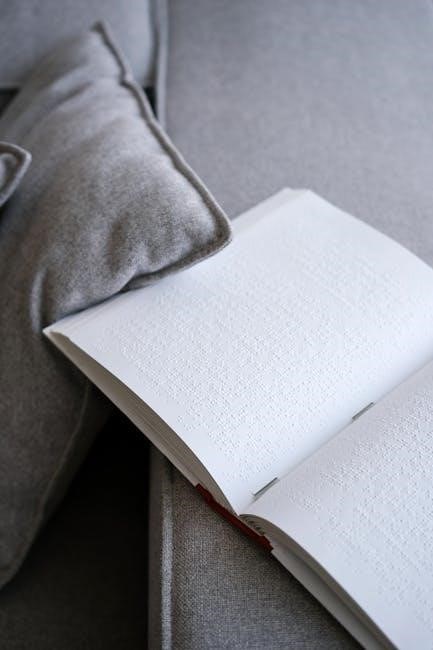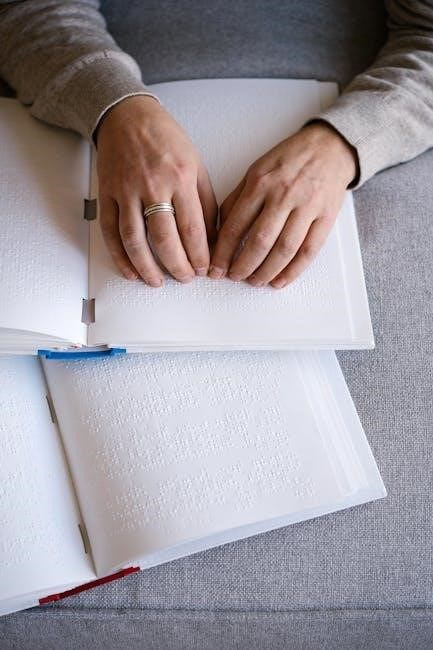Tarot is a profound tool for self-discovery‚ intuition‚ and personal growth. Originating centuries ago‚ it offers insights into life’s complexities‚ blending psychology‚ spirituality‚ and symbolism for mindful reflection and empowerment.
Understanding the Basics of Tarot Cards and Their History
Tarot cards are a set of 78 cards‚ divided into the Major and Minor Arcana. The Major Arcana represents life’s major themes and transitions‚ while the Minor Arcana reflects everyday situations. Originating in 15th-century Europe as a game‚ tarot later evolved into a tool for divination and self-reflection. Each card carries symbolic imagery and meanings‚ drawing from mythology‚ astrology‚ and psychology. Understanding tarot involves mastering its historical roots and interpreting its layered symbolism. This ancient practice has grown into a global phenomenon‚ offering insights into past‚ present‚ and future‚ while fostering personal growth and introspection.

Structure of a Tarot Deck
A standard tarot deck contains 78 cards‚ divided into the Major Arcana (22 cards) and Minor Arcana (56 cards). The Minor Arcana includes four suits and court cards.
Major Arcana vs. Minor Arcana: Key Differences and Meanings
The Major Arcana consists of 22 cards‚ each representing significant life themes‚ archetypes‚ and spiritual lessons; Cards like The Fool and The Lovers symbolize major transitions and deep personal growth. In contrast‚ the Minor Arcana includes 56 cards‚ divided into four suits (Wands‚ Cups‚ Swords‚ and Pentacles)‚ reflecting everyday situations and emotions. While the Major Arcana offers profound insights into life’s purpose‚ the Minor Arcana provides guidance on practical matters and fleeting challenges. Together‚ they create a holistic system for self-reflection and understanding life’s complexities.

Choosing the Right Tarot Deck for Beginners
Select a deck with clear‚ intuitive imagery and a comprehensive guidebook. Popular choices include the Rider-Waite or Everyday Tarot‚ offering detailed meanings for easy understanding.
Factors to Consider When Selecting Your First Tarot Deck
When choosing your first tarot deck‚ consider imagery that resonates with you‚ as it aids intuition. Themes like nature or mythology can align with personal interests. Ensure the deck includes a guidebook for card meanings. Deck size and card quality matter for handling comfort. Read reviews to gauge suitability for beginners. Trust your intuition—select a deck that feels right. Avoid overly complex designs that might confuse. A deck with clear symbolism‚ like the Rider-Waite‚ is ideal for learning. Prioritize a set that balances aesthetics‚ functionality‚ and ease of understanding to enhance your tarot journey.

Understanding Tarot Card Meanings
Understanding tarot card meanings involves interpreting symbolism‚ intuition‚ and psychological insights. Each card reflects life situations‚ emotions‚ and archetypes‚ offering guidance for relationships‚ career‚ and personal growth.
Interpreting Upright and Reversed Card Interpretations
Understanding upright and reversed tarot card meanings is crucial for deeper insights. Upright cards typically represent their core symbolism‚ offering clear guidance‚ while reversed cards suggest challenges‚ blockages‚ or alternative perspectives. For example‚ the upright Lovers card signifies harmony and relationships‚ but when reversed‚ it may indicate delays or misalignment in love. Reversed cards can also emphasize the need for reflection or overcoming obstacles. By mastering both interpretations‚ readers can uncover nuanced truths and provide more comprehensive guidance. This dual perspective enriches readings‚ helping to address complex life situations with sensitivity and accuracy.
Essential Tarot Spreads for Beginners
Beginners can start with simple spreads like the One-Card Draw for daily insights‚ Past-Present-Future for timelines‚ and Four Directions for balanced perspectives‚ fostering clear and focused readings.
Examples of Simple and Effective Spreads for Various Readings
Simple tarot spreads are perfect for beginners‚ offering clear guidance without complexity. The One-Card Draw provides instant insights for daily reflection‚ while the Three-Card Spread reveals past‚ present‚ and future dynamics. The Celtic Cross is a classic for deeper exploration of challenges and outcomes. For relationships‚ the Two-Card Comparison highlights energies between individuals. These spreads are versatile‚ helping you navigate various life situations with clarity and purpose‚ making tarot accessible and practical for everyday use.
Tarot and Its Connection to Other Practices
Tarot connects deeply with astrology‚ numerology‚ and psychology‚ offering a holistic understanding of self and universe. These practices enrich tarot readings‚ revealing deeper life patterns and meanings.
How Astrology‚ Numerology‚ and Psychology Relate to Tarot
Tarot deeply intertwines with astrology‚ numerology‚ and psychology‚ offering a multidimensional understanding of life. Astrology links tarot cards to zodiac signs and planetary influences‚ while numerology connects card numbers to symbolic meanings. Psychology‚ particularly Jungian archetypes‚ explores the subconscious themes in tarot imagery. Together‚ these practices enhance tarot readings‚ revealing personality traits‚ life cycles‚ and emotional landscapes. This holistic approach allows for deeper self-reflection‚ personal growth‚ and alignment with universal energies‚ making tarot a powerful tool for introspection and transformation.

Using Tarot for Personal Growth and Manifestation
Tarot empowers personal growth by revealing patterns‚ clarifying intentions‚ and aligning energies for positive change. It helps manifest goals‚ fostering a mindset of transformation and self-awareness.
Practical Tips for Applying Tarot in Everyday Life
Start with a daily draw to set intentions and gain insights for the day. Use simple spreads like the three-card layout for clarity on past‚ present‚ and future. Journal your readings to track patterns and personal growth. Practice tarot meditation to connect deeply with card meanings. Incorporate tarot into decision-making by drawing a card for guidance. Use tarot to manifest goals by focusing on outcome-oriented spreads. Keep a tarot journal to reflect on progress and insights over time. Experiment with tarot rituals to enhance mindfulness and intention-setting. Make tarot a part of your self-care routine for emotional clarity and balance.

Advanced Tarot Techniques for Experienced Readers
Master complex spreads‚ synastry readings‚ and multi-card interpretations. Explore tarot astrology connections‚ numerology‚ and symbolic layering. Advanced techniques unlock deeper insights and transformative perspectives for seasoned practitioners.
Exploring Complex Spreads and Deep Interpretations
Advanced tarot techniques involve intricate spreads like the Tree of Life or astrological layouts‚ offering a holistic view of complex situations. These methods connect multiple cards‚ revealing subtle patterns and deeper symbolism. Experienced readers can explore synastry readings‚ combining personal and relational cards for profound insights. Deep interpretations require mastering card interactions‚ numerology‚ and psychological layers. Books like Seventy-Eight Degrees of Wisdom and Holistic Tarot provide frameworks for advanced analysis. By integrating intuition and esoteric knowledge‚ readers uncover hidden meanings‚ making tarot a powerful tool for personal and spiritual growth. Continuous practice and study are essential for mastery.
Recommended Tarot Books for All Levels
Top-rated books like The Ultimate Guide to Tarot and Tarot Wisdom offer insights for beginners and advanced readers‚ covering card meanings‚ spreads‚ and deep interpretations for all skill levels.
Top-Rated Books for Beginners‚ Intermediate‚ and Advanced Readers
For beginners‚ The Ultimate Guide to Tarot by Liz Dean and The New Tarot Handbook by Rachel Pollack are excellent starting points‚ offering clear guides to card meanings and spreads. Intermediate readers benefit from Holistic Tarot by Benebell Wen‚ which combines tarot with personal growth and intuition. Advanced readers can explore Seventy-Eight Degrees of Wisdom‚ also by Rachel Pollack‚ for deep psychological insights‚ or 21 Ways to Read a Tarot Card by Mary K. Greer for advanced interpretation techniques. These books cater to all skill levels‚ ensuring a comprehensive tarot education.
Incorporating Tarot into Daily Life
Using tarot cards daily can enhance decision-making‚ aid in goal setting‚ and foster personal growth through mindful reflection and intuition. Incorporate tarot into your routine for clarity and empowerment.
How to Use Tarot for Decision-Making and Goal Setting
Tarot is a powerful tool for guiding decisions and setting intentions. Start by framing your question or goal clearly‚ then draw cards to uncover insights and options. Use spreads like the three-card layout (past-present-future or situation-action-outcome) to gain clarity. Reflect on the symbolism and themes in the cards to align your choices with your values. For goal setting‚ break down objectives into steps and use tarot to identify potential obstacles or strategies. Incorporate daily rituals‚ such as drawing a single card for focus‚ to stay aligned with your intentions and manifest desired outcomes.

The Future of Tarot in the Digital Age
Tarot is evolving with technology‚ offering digital decks‚ apps‚ and online platforms for accessible readings. Virtual tools enhance learning‚ making tarot more engaging for modern enthusiasts and seasoned readers alike.
Modern Tools and Resources for Tarot Enthusiasts
Today‚ tarot enthusiasts can explore a wide range of digital tools and resources. Apps like Biddy Tarot and Labyrinthos offer virtual decks‚ guided spreads‚ and interactive learning. Online communities‚ such as forums and social media groups‚ connect readers worldwide‚ fostering collaboration and growth. AI-powered tarot platforms provide instant readings and personalized interpretations‚ making tarot more accessible. Additionally‚ virtual reality experiences and live-streamed tarot classes are revolutionizing how people engage with the practice. These modern innovations ensure that tarot remains vibrant and evolving‚ catering to both beginners and advanced readers in a dynamic‚ tech-driven world.
